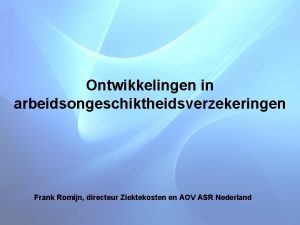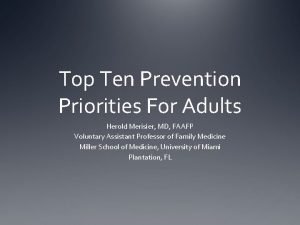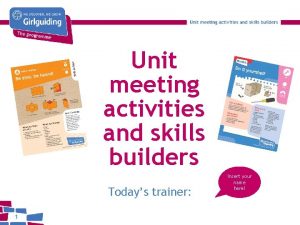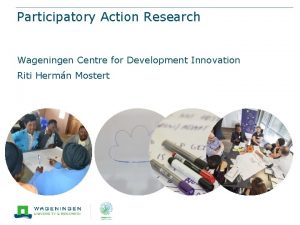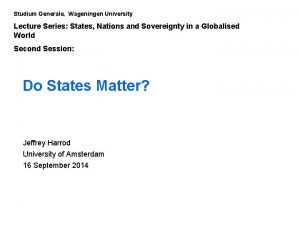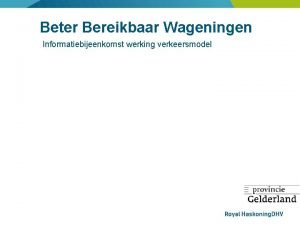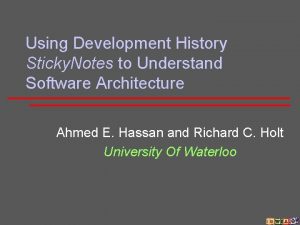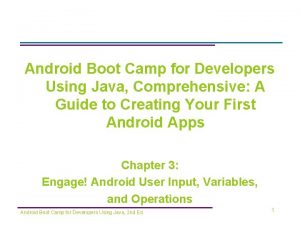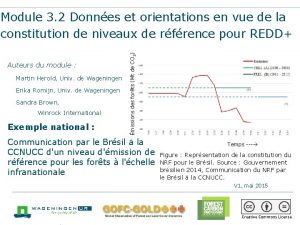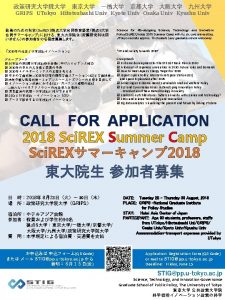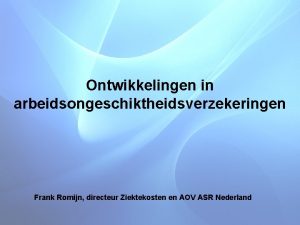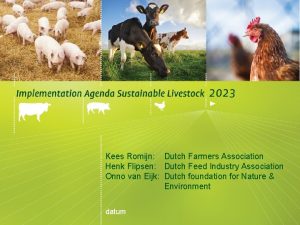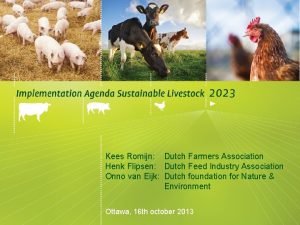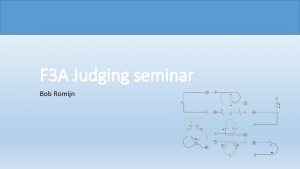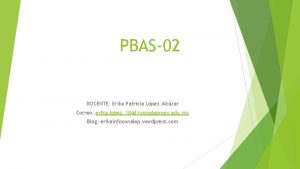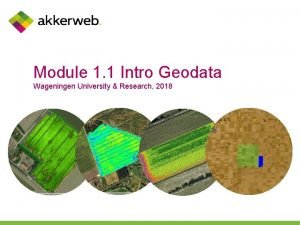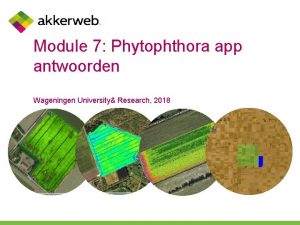Module developers Martin Herold Wageningen Univ Erika Romijn











- Slides: 11

Module developers: Martin Herold, Wageningen Univ. Erika Romijn, Wageningen Univ. Sandra Brown, Winrock International Country example: Forest emissions (Mt. CO 2) Module 3. 2 Data and guidance on developing REDD+ reference levels Brazil’s submission of a subnational forest reference emission level to the UNFCCC Time --- Figure: Representation of FRL development for Brazil. Source: GOB 2014, Brazil’s submission of FRL to UNFCCC. V 1, May 2015 Module 3. 2 Data and guidance on developing REDD+ reference levels REDD+ training materials by GOFC-GOLD, Wageningen University, World Bank FCPF 1 Creative Commons License

Brazil’s submission of a subnational forest reference emission level to the UNFCCC § Subnational FRL: ● Selected region: Amazonia ● Selected activity: deforestation ● Selected pools: aboveground biomass, belowground biomass, litter § Eventually the national FRL will consist of the sum of subnational FRLs for six biomes § FRL for degradation is under construction Module 3. 2 Data and guidance on developing REDD+ reference levels REDD+ training materials by GOFC-GOLD, Wageningen University, World Bank FCPF 2

Brazil’s submission of a subnational forest reference emission level to the UNFCCC § Submission follows the guidelines from UNFCCC (2012, Decision 12 / CP 17, part 2, annex). Submission includes: 1. Information that was used in constructing the FRL 2. Transparent, complete, consistent, and accurate information, including methodological information, used at the time of construction of FRLs, including a description of datasets, approaches, and methods 3. Pools and gases, and activities that have been included in the FRL 4. The definition of forest used in construction of the FRL Module 3. 2 Data and guidance on developing REDD+ reference levels REDD+ training materials by GOFC-GOLD, Wageningen University, World Bank FCPF 3

1. Information that was used in constructing the FRL § Approach 3 activity data: annual deforestation polygons based on analysis of Landsat satellite data (30 m. res. ) § Emission factors for each distinct forest type § Yearly calculation of CO 2 emissions from 1996 -2010: GEt = total emission from gross deforestation at year t (in tonnes CO 2) GEi, j = CO 2 emission associated with deforested polygon i under forest type j (in tonnes CO 2) N = number of new deforested polygons in year t p = number of forest types Module 3. 2 Data and guidance on developing REDD+ reference levels REDD+ training materials by GOFC-GOLD, Wageningen University, World Bank FCPF 4

1. Information that was used in constructing the FRL § FRL reflects dynamic mean of annual CO 2 emissions and Forest emissions (Mt. CO 2) is updated every five years Source: GOB 2014, Brazil’s submission of FRL to UNFCCC. Time --- Module 3. 2 Data and guidance on developing REDD+ reference levels REDD+ training materials by GOFC-GOLD, Wageningen University, World Bank FCPF 5

2. Transparent, complete, consistent, and accurate information § Transparency: ● Detailed description of all data, methods, and products § Completeness: ● All satellite images, data, and products available § Consistency: ● Same methods and data used to estimate and report § emissions in the national greenhouse gas (GHG) inventory and to construct the FRL Accuracy: ● AD: use of Landsat data with high accuracy ● EF: still many uncertainties in the data Module 3. 2 Data and guidance on developing REDD+ reference levels REDD+ training materials by GOFC-GOLD, Wageningen University, World Bank FCPF 6

3. Pools and gases, and activities included in FRL development § Pools: ● Aboveground biomass ● Belowground biomass ● Litter § Gases: ● CO 2 emissions § Activity: ● Deforestation Module 3. 2 Data and guidance on developing REDD+ reference levels REDD+ training materials by GOFC-GOLD, Wageningen University, World Bank FCPF 7

4. The definition of forest used in construction of the FRL § Food and Agriculture Organization definition of forest: ● Land > 0. 5 hectare ● Trees > 5 meters ● Canopy cover > 10% § Deforestation = clear-cut based on total tree cover loss within the minimum mapping unit of 6. 25 hectares (250 x 250 m) § Other types of loss, where the canopy thresholds stays over 0%, are regarded as forest degradation Module 3. 2 Data and guidance on developing REDD+ reference levels REDD+ training materials by GOFC-GOLD, Wageningen University, World Bank FCPF 8

Recommended modules as follow-up § Module 3. 3 to continue with guidance on reporting REDD+ performance using IPCC Guidelines and Guidance Module 3. 2 Data and guidance on developing REDD+ reference levels REDD+ training materials by GOFC-GOLD, Wageningen University, World Bank FCPF 9

References § GOB (Government of Brazil). 2014. Brazil’s Submission of a Forest Reference Emission Level for Deforestation in the Amazonia Biome for Results-based Payments for REDD+ under the UNFCCC. 2014. Brazília. https: //unfccc. int/files/land_use_and_climate_change/redd/application/pdf/20140606_submission_frel_ brazil. pdf. § IPCC, 2003 Good Practice Guidance for Land Use, Land-Use Change and Forestry, Prepared by the National Greenhouse Gas Inventories Programme, Penman, J. , Gytarsky, M. , Hiraishi, T. , Kruger, D. , Pipatti, R. , Buendia, L. , Miwa, K. , Ngara, T. , Tanabe, K. , Wagner, F. (eds. ). Published: IGES, Japan. http: //www. ipcc-nggip. iges. or. jp/public/gpglulucf. html (Often referred to as IPCC GPG) § UNFCCC (United Nations Framework Convention on Climate Change). 2014. Decision 13/CP. 19. Guidelines and procedures for the technical assessment of submissions from parties on proposed forest reference emission levels and/or forest reference levels. http: //unfccc. int/resource/docs/2013/cop 19/eng/10 a 01. pdf#page=34. Module 3. 2 Data and guidance on developing REDD+ reference levels REDD+ training materials by GOFC-GOLD, Wageningen University, World Bank FCPF 10

§ UNFCCC. 2012. Decision 12/CP. 17. Report of the Conference of the Parties on its seventeenth session, held in Durban from 28 November to 11 December 2011: Part Two: Action taken by the Conference of the Parties at its seventeenth session. http: //unfccc. int/resource/docs/2011/cop 17/eng/09 a 02. pdf#page=16. § UN-REDD. 2014. Emerging Approaches to Forest Reference Emission Levels and/or Forest Reference Levels for REDD+. Rome: Food and Agriculture Organization. www. unredd. net/index. php? option=com_docman&task=doc_download&gid=13473&Itemid=53. Module 3. 2 Data and guidance on developing REDD+ reference levels REDD+ training materials by GOFC-GOLD, Wageningen University, World Bank FCPF 11
